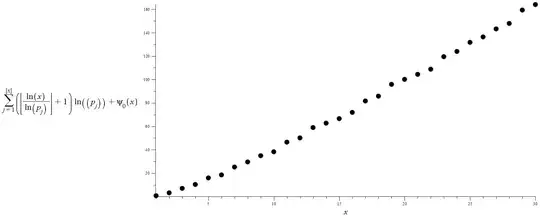In looking at the two functions defined: $$\psi_{{0}}(x)=\ln( \operatorname{lcm}(1,2,3,...,\lfloor x \rfloor))$$
$$\psi_{{1}}(x)=\sum _{j=1}^{ \lfloor x \rfloor } \sum _{i=0}^{ \Bigl\lfloor {\frac {\ln \left( x \right) }{\ln \left( p_{{j}} \right) }} \Bigr\rfloor +1}\ln \left( {p_{{j}}}^{i} \right) $$ (where $p_n$ is the $n^{th}$ prime and $lcm$ denontes the lowest common multiple of the arguments enclosed)
I am interested in finding the minimum value (if it exists) of $n \in \mathbb N$ that satisfies:
$$ {\Biggl\{\frac{\left(\lfloor \ln \left( \psi_{{0}}(n)+\psi_{{1}}(n)\right) \rfloor +1 \right) !}{\lfloor \sqrt n \rfloor!}}\Biggr\} \ne 0$$
where ${\{x}\}$ denotes the fractional part of $x$.
some values evaluated: $$\frac{\left(\lfloor \ln \left( \psi_{{0}}(8)+\psi_{{1}}(8)\right) \rfloor +1 \right) !}{\lfloor \sqrt 8 \rfloor!}=12$$ $$\frac{\left(\lfloor \ln \left( \psi_{{0}}(12)+\psi_{{1}}(12)\right) \rfloor +1 \right) !}{\lfloor \sqrt 12 \rfloor!}=20$$
$$\frac{\left(\lfloor \ln \left( \psi_{{0}}(20)+\psi_{{1}}(20)\right) \rfloor +1 \right) !}{\lfloor \sqrt 20 \rfloor!}=5$$
The value is less than 1 at $n=36$ indicating this to be the immeadiate border of the region of $\mathbb N$ for which the inequality Carl mentioned begins to be true (inductively reasoning).
Beyond $0<n<32$ I am not as yet able to produce a result, float approximations continue to imply that the value is 0 up to $n=40$, however really what is needed here is someone with more experience in number theory to assess the situation and give an opinion as to whether it is worth pursuing or not.
Closely related to the relations in a previous questions I posted here and here
I will try my best to follow along with Carl's answer, he has skipped a few steps that are probably what he may consider too obvious to show, but so far: Because: $$\psi_{{0}}(x)=\ln(\operatorname{lcm}(1,2,3,...,x-1,\lfloor x\rfloor))=\alpha\,\ln \left( 2 \right) +\beta\,\ln \left( 3 \right)... +\sum _{j= 1}^{ \lfloor x \rfloor }\ln \left( p_{{j}} \right) $$ for some $$\alpha, \beta,... \in \mathbb N$$
And similarly:
$$\psi_{{1}}(x)=\sum _{j=1}^{ \lfloor x \rfloor } \sum _{i=0}^{ \Bigl\lfloor {\frac {\ln \left( x \right) }{\ln \left( p_{{j}} \right) }} \Bigr\rfloor +1}\ln \left( {p_{{j}}}^{i} \right) =\frac{1}{2}\sum _{j=1}^{ \lfloor x \rfloor }\ln \left( p_{{j}} \right) \left( \Bigl\lfloor {\frac {\ln \left( x \right) }{ \ln \left( p_{{j}} \right) }} \Bigr\rfloor +2 \right) \left( \Bigl\lfloor {\frac {\ln \left( x \right) }{\ln \left( p_{{j}} \right) }} \Bigr\rfloor +1 \right)$$ $$=\alpha'\,\ln \left( 2 \right) +\beta'\,\ln \left( 3 \right)... +\sum _{j= 1}^{ \lfloor x \rfloor }\ln \left( p_{{j}} \right) $$ for some $$\alpha', \beta',... \in \mathbb N$$
The asymptotic relation I think I originally started from, which think is actually false as I originally stated, but again, just curious about the division relation on the naturals I really am new to asymptotics:
$$\sum _{j=1}^{ \lfloor x \rfloor } \left( \Bigl\lfloor
{\frac {\ln \left( x \right) }{\ln \left( p_{{j}} \right) }}
\Bigr\rfloor +1 \right) \ln \left( p_{{j}} \right)+\psi_{{0}}(x) \sim x
$$
